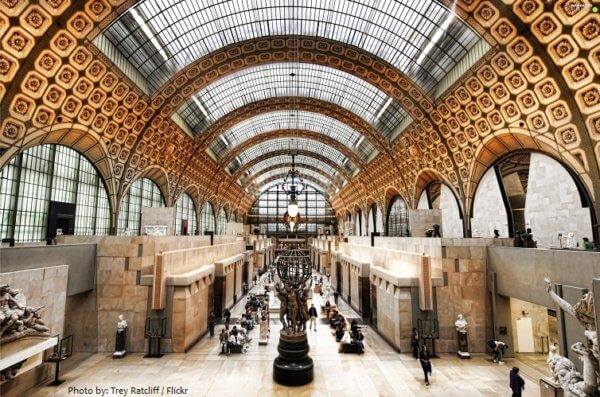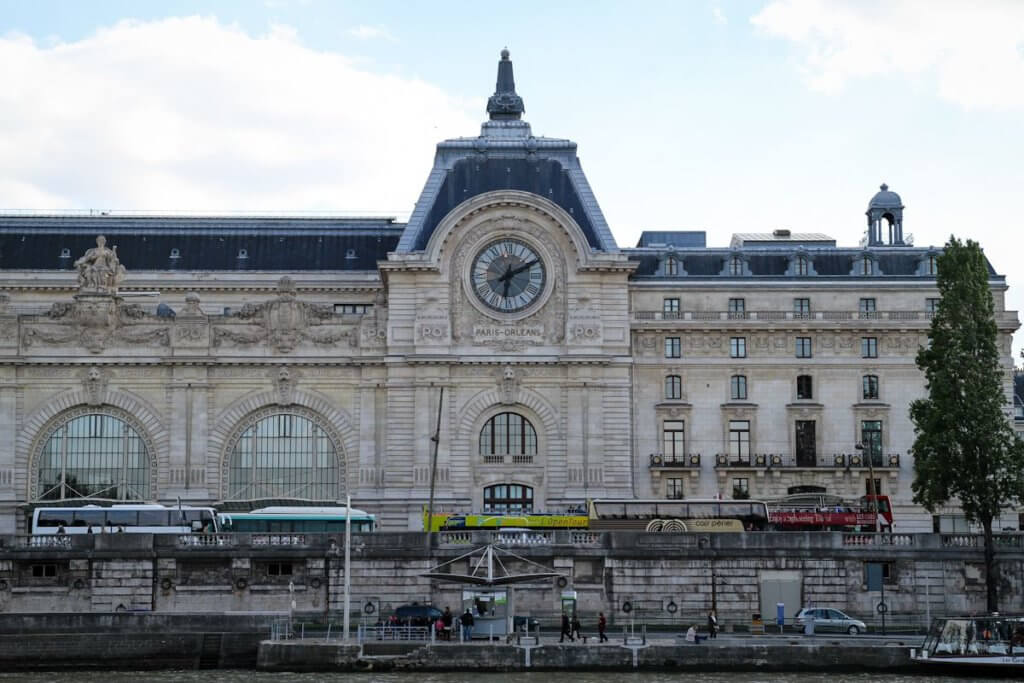The Orsay Museum is, without a doubt, a must for those who go to Paris and, above all, for those who love impressionist and post-impressionist painting.
The museum, which is located in the center of Paris on the left bank of the Seine, is in fact the most important French gallery that houses paintings of these two artistic currents, collecting many masterpieces.
The structure of the Orsay Museum
The structure of the Orsay Museum, however, was not born as a museum but as a railway station, built in the style of Eclecticism, which blends different lines, materials and methods.
This railway station, created in 1898 and completed in just two years, in order to be ready for the Universal Exhibition in Paris in 1900, was closed in 1939.
Its majesty and very favorable location, in fact it is located in a strategically very important place, almost opposite the Louvre Museum, however, made sure that it was not abandoned and, therefore, that it was not damaged by neglect.
After several uses and even averted the risk of being demolished, the building, between the 70s and 80s, was recovered, renovated and transformed into a wonderful exhibition space, which was inaugurated in December 1986.
The recovery project was entrusted to three Frenchmen, Renaud Bardon, Pierre Colboc and Jean-Paul Philippon, who tried not to upset the initial project of the railway station; while the layout of the interior spaces and the design of the exhibition paths were entrusted to the famous Italian architect Gae Aulenti, who began his rise precisely with this important work.
The exhibition itinerary
The exhibition path of the Orsay Museum, created by Aulenti, is divided into three levels.
The central nave, where the train tracks ran, was used as the main element from which passages and terraces develop, which allow visitors to pass from one pavilion to another, where the works are contained, ranging from beginning of the Second Republic (1848) at the beginning of the First World War (1914).
These chronological limits, however, are not so strict, in fact the Paris Museum also houses works by Renoir and Monet after 1914 and dated 1920 and 1930.
The beautiful Musée d’Orsay, which already for its structure alone represents a real work of art, collects all those paintings that could not be exhibited either at the Louvre Museum or at the Center Pompidou, where the National Museum of ‘Modern Art.
Thus, from the Louvre, the works of artists who worked during the Second Republic and painters born around 1820 arrived at the Orsay Museum, works of great value but kept in the deposits due to lack of space; while the works prior to 1914, the year in which contemporary art was started, arrived from the National Museum of Modern Art.
Finally, other works come from the former Jeu de Paume museum, which collected works of contemporary art and which sold its impressionist paintings, sacrificed and diminished in a location that did not enhance their value.
Born many years after the Louvre, built as a fortress and then became the very famous museum that houses countless works of classical and modern art, the Musée d’Orsay therefore mainly collects paintings by impressionists and post-impressionists, but also collections of other artistic disciplines, such as photography, sculpture, with the sculptures of Auguste Rodin, considered the progenitor of modern sculpture, works of graphic arts and decorative arts, without forgetting the section dedicated to Henry de Toulouse Lautrec, the painter who portrayed dancers of can can of the Moulin Rouge, Pigalle’s cabaret club.
What to see: the most important works
 Those who decide to pay a visit to Musee d’Orsay, therefore, find themselves in front of the greatest masters of Impressionism (Claude Monet, Paul Cezanne, Edgar Degas, Edouard Manet, Pierre Auguste Renoir) and of post-impressionism (Paul Gauguin and Vincent van Gogh), whose masterpieces have become the hallmark of this prestigious Parisian gallery.
Those who decide to pay a visit to Musee d’Orsay, therefore, find themselves in front of the greatest masters of Impressionism (Claude Monet, Paul Cezanne, Edgar Degas, Edouard Manet, Pierre Auguste Renoir) and of post-impressionism (Paul Gauguin and Vincent van Gogh), whose masterpieces have become the hallmark of this prestigious Parisian gallery.
Not to be missed, therefore, among the many pictorial works present, will be: “The dance class” by Degas (1871-1874), “Bal au moulin de la Galette” by Renoir (1876), the famous self-portrait by van Gogh ( 1889), Cezanne’s “The Card Players” (1890-1895), Gauguin’s “Arearea” (1892), Manet’s “Portrait of Emile Zola” (1868), just to name a few.
It should also be noted that the collections exhibited at the Orsay Museum are enriched and expanded from year to year, thanks to loans or donations from other museums or private individuals, who sell or lend their works.
This means that those who return to the Parisian gallery, several times, can always find some new work, which was not there in the previous visit.
Inside the Orsay Museum, however, there are not only paintings, sculptures and other kinds of works but there is also the opportunity to attend various events that represent and are part of the historical period of the works on display and which are organized in the Auditorium.
There are also concerts, exhibitions, shows and even conferences and lectures, of course, in French.
And, finally, unmissable, it is also a restaurant, where you can taste the dishes of the traditional French cuisine of the early ‘900 and which are served in a room, considered a historical monument, since this too, like the Museum of Orsay, dates back to the twentieth century.
Where is it and how to get there
1 Rue de la Legion d’Honneur, 7th arrondissement, Paris. By Metro: line 12 Solferino stop; by Bus: 24-68-69; RER C train, Musee d’Orsay stop

